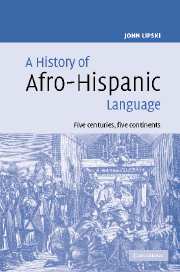Book contents
- Frontmatter
- Contents
- Acknowledgments
- Note on the Appendix
- Introduction
- 1 Africans in the Iberian peninsula, the slave trade, and overview of Afro-Iberian linguistic contacts
- 2 Early Afro-Portuguese texts
- 3 Early Afro-Hispanic texts
- 4 Africans in colonial Spanish America
- 5 Afro-Hispanic texts from Latin America: sixteenth to twentieth centuries
- 6 Survey of major African language families
- 7 Phonetics/phonology of Afro-Hispanic language
- 8 Grammatical features of Afro-Hispanic language
- 9 The Spanish-Creole debate
- References
- Index
6 - Survey of major African language families
Published online by Cambridge University Press: 24 February 2010
- Frontmatter
- Contents
- Acknowledgments
- Note on the Appendix
- Introduction
- 1 Africans in the Iberian peninsula, the slave trade, and overview of Afro-Iberian linguistic contacts
- 2 Early Afro-Portuguese texts
- 3 Early Afro-Hispanic texts
- 4 Africans in colonial Spanish America
- 5 Afro-Hispanic texts from Latin America: sixteenth to twentieth centuries
- 6 Survey of major African language families
- 7 Phonetics/phonology of Afro-Hispanic language
- 8 Grammatical features of Afro-Hispanic language
- 9 The Spanish-Creole debate
- References
- Index
Summary
Introduction
Among the corpus of bozal Spanish and Portuguese materials, none of the texts show the neat template-like superposition of Romance and African language patterns found among creole languages, perhaps not surprising in view of the fact that bozal language was re-created spontaneously each time a diverse group of Africans was thrust into a situation where learning Spanish or Portuguese was instantly necessary. Despite the lack of systematic one-to-one correspondences between grammatical structures peculiar to individual African languages and bozal Spanish or Portuguese, there are some recurring traits among major African languages whose traces among Afro-Iberian speech can potentially be separated from the spontaneous effects of imperfect second language acquisition. Among later bozal texts, particularly those from the nineteenth and early twentieth centuries, there is a higher overall degree of linguistic accuracy, and even some attempts at anthropological accounts of Afro-Hispanic language and culture. Available documentation on the demographics of the African population in nineteenth-century Latin America is also more complete, and there are occasional glimpses of substratum influence on bozal Spanish syntax. An assessment of several prominent cross-sections of African grammatical structures is therefore not without merit, even in the absence of stable creoles. The following survey is not intended to be complete, but rather to underscore the type of considerations that might be brought to bear on individual bozal texts in order to fathom the possible effects of African grammatical patterns.
- Type
- Chapter
- Information
- A History of Afro-Hispanic LanguageFive Centuries, Five Continents, pp. 197 - 203Publisher: Cambridge University PressPrint publication year: 2005

